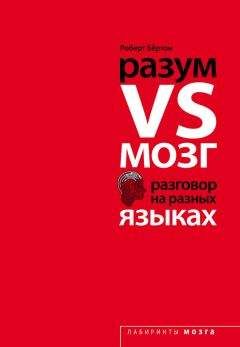Салли Сэйтл - Нейромания. Как мы теряем разум в эпоху расцвета науки о мозге
(48) Katherine H. Federle and Paul Skendalis, “Thinking Like a Child: Legal Implications of Recent Developments in Brain Research for Juvenile Offenders”, in Law, Mind, and Brain, ed. Michael Freeman and Oliver R. Goodenough (Surrey, UK: Ashgate, 2009), esp. 214; «Сенатор из Скоттблаффа Джон Хармс (John Harms) [в Небраске] выразил свою озабоченность тем, что 18-летние граждане подписывают контракты и договоры об аренде, поскольку исследования указывают на то, что их мозг еще не полностью развит», в “Senators Advance Bill That Would Add Rights for Some Youth”, Unicameral Update: The Nebraska Legislature’s Weekly Publication 33, no. 4 (January 25-29, 2010), 10, http://nlcl.nlc.state.ne.us/epubs/L3000/N001- 2010.pdf. Об абортах см.: Frederico C. de Miranda, “Parental Notification/ Consent for Treatment of the Adolescent”, American College of Pediatricians, Position Statement, May 17, 2010, http://www.acpeds.org/Parental-Notifi- cation/Consent-for-Treatment-of-the-Adolescent.html. См. также: Laurence Steinberg, “Are Adolescents Less Mature Than Adults? Minors’ Access to Abortion, the Juvenile Death Penalty, and the Alleged APA ‘Flip-Flop,’ ” American Psychologist 64 no. 7 (2009): 583-594; и William Saletan, “Rough Justice; Scalia Exposes a Flip Flop on the Competence of Minors”, Slate, March 2, 2005, http://www.slate.com/id/2114219. Об агрессивных видеоиграх см.: “Brief of Amicus Curiae: Common Sense Media in Support of Petitioners”, sec. 1, July 19, 2010, http://www.americanbar.org/content/dam/aba/pub- lishing/preview/publiced_preview_briefs_pdfs_09_10_08_1448_Petitioner- AmCuCommonSenseMedia. authcheckdam.pdf; и Jeneba Ghatt, “Supreme Court Overreaches on Video Game Ruling”, Washington Post, June 30, 2011.
(49) Francis X. Shen, “Law and Neuroscience: Possibilities for Prosecutors”, CDAA Prosecutors Brief 33, no. 4 (2011): 17-23; O. Carter Snead, “Neuroimaging and Capital Punishment”, New Atlantis 19 (2008): 35-63; Hughes, “Science in Court” (упоминание феномена «палки о двух концах» в статье о деле Дугана); и Brent Garland and Mark S. Frankel, “Considering Convergence: A Policy Dialogue About Behavioral Genetics, Neuroscience, and Law”, Law and Contemporary Problems 69 (Winter/Spring 2006): 101-113. Этот момент отмечали и другие, включая Nita A. Farahany and James Е. Coleman Jr., “Genetics and Responsibility: To Know the Criminal from the Crime”, Law and Contemporary Problems 69 (Winter/Spring 2006): 115- 164; и Abram S. Barth, “ADouble-E dged Sword: The Role of Neuroimaging in Federal Capital Sentencing”, American Journal of Law and Medicine 33 (2007): 501-522. Об опасности, которую представляют собой обвиняемые, см.: Thomas Nadelhoffer and Walter Sinnott-Armstrong, “Neurolaw and Neuroprediction: Potential Promises and Perils”, Philosophy Compass 7, no. 9 (2012): 631-642; и Erica Beecher-Monas and Edgar Garcia-Rill, “Danger at the Edge of Chaos: Predicting Violent Behavior in a Post-Daubert World”, Cardozo Law Review 24 (2003): 1845-1897. Доклад Бичер-Монас (Beecher-Monas) и Гарсиа-Рилла (Garcia-Rill) о том, что судьи придают не меньшее, а возможно, даже большее значение потенциальной опасности обвиняемого в будущем, нежели таким факторам, как отсутствие раскаяния, психическое заболевание, уровень интеллекта или злоупотребление психотропными веществами. Генетические аргументы могут быть использованы и для усиления наказания, а не только для смягчения. См.: Farahany and Coleman, “Genetics and Responsibility.” В 2011 году Федеральный апелляционный суд Манхэттена отменил приговор к 6,5 годам лишения свободы по делу о детской порнографии, указав, что судья, вынесший его, пришел к неоправданному заключению, что обвиняемый вернется к просмотру детской порнографии из-за наличия у него пока еще не открытого гена. Судья Гэри Л. Шарп (Gary L. Sharpe) из федерального окружного суда в Олбани произнес следующие слова (как было процитировано): «Это ген, с которым вы родились. И вы от него не можете избавиться», перед тем как приговорить обвиняемого. Benjamin Weiser, “Court Rejects Judge’s Assertion of a Child Pornography Gene”, New York Times, January 28, 2011.
(50) Steven K. Erickson, “The Limits of Neurolaw”, Houston Journal of Health Law and Policy 11 (2012): 303-320, http://www.law.uh.edu/ hjhlp/Issues/Vol_112/Steven%20Erickson.pdf. Фараани замечает, что «во многих из этих случаев [жестоких сексуальных маньяков] штат, а не уголовный обвиняемый, приводит неврологические доказательства для обоснования выводов о потенциальной опасности в будущем,
чтобы продлить действующую или оправдать новую принудительную госпитализацию», в Nita A. Farahany, “Daily Digest”, Center for Law and the Biosciences, Stanford Law School, March 16, 2011, http://blogs.law. stanford.edu/lawandbiosciences/2011/03/16/the-daily-digest-31611/. См. также: Fredrick E. Vars, “Rethinking the Indefinite Detention of Sex Offenders”, Connecticut Law Review 44, no. 1 (2011): 161-195, http:// uconn.lawreviewnetwork.com/files/2012/01/Vars.pdf. Adam Lamparello, “Why Wait Until the Crime Happens? Providing for the Involuntary Commitment of Dangerous Individuals Without Requiring a Showing of Mental Illness”, Seton Hall Law Review 41, no. 3 (2011): 875-908.
(51) Существует ответственность за то, чтобы удерживать себя от попадания в ситуации, представляющие собой значительную угрозу окружающим, например вождение под воздействием алкоголя или наркотиков. Это иллюстрирует знаменательное дело Эмиля Десины (Emil Decina), эпилептика из Нью-Йорка, сбившего намертво четверых детей, когда его «Бьюик» потерял управление в момент приступа. Десина был предупрежден о том, что у него могут случиться судороги за рулем, тем не менее он решил водить машину. Суд обвинил его в убийстве по неосторожности, поскольку причиной было его решение пренебречь риском. People v. Decina, 2 N.Y.2d 133 (1956). Слова Ресника приведены в: Brian Doherty, “You Can’t See Why on an fMRI: What Science Can, and Can’t, Tell Us About the Insanity Defense”, Reason, July 2007, http:// reason, com/archives/2007/06/19/you-cant-see-why-on-an-fmri.
(52) P.S. Applebaum, “Through a Glass Darkly: Functional Neuroimaging Evidence Enters the Courtroom”, Psychiatric Services 60, no. 1 (2009): 21-23, 23; L.R. Tancredi and J.D. Brodie, “The Brain and Behavior: Limitations of the Legal Use of Functional Magnetic Resonance Imaging”, American Journal of Law and Medicine 33 (2007): 271. Суды по-прежнему должны полагаться на свидетельства, которые специалисты по психическому здоровью и неврологи получают с помощью обычных анализов, опросов, наблюдений
и сообщений тех, кто хорошо знает обвиняемого или присутствовал на месте преступления. С.М. Filley, “Toward an Understanding of Violence: Neu- robehavioral Aspects of Unwarranted Physical Aggression; Aspen Neurobehav- ioral Conference Consensus Statement”, Neuropsychiatry, Neuropsychology, and Behavioral Neurology 14, no. 1 (2001): 1-14. Совместное заключение Аспенской нейроповеденческой конференции (Aspen Neurobehavioral Conference), написанное в 2000 году и подписанное специалистами по неврологии, психиатрии, праву и психологии, предупреждало о необоснованности установления непосредственной связи между дисфункцией мозга и насилием. «Насилие возникает в социальном контексте, и прочие сопутствующие факторы, такие как эмоциональный стресс, нищета, групповое влияние, алкоголь и другие наркотики, жестокое обращение в детстве и распад семьи, тоже оказывают влияние» (3).
(53) Неспособность сформировать намерение весьма маловероятна, за исключением случаев, когда когнитивные нарушения очень велики и очевидны. См.: Laura Stephens Khoshbin and Shahram Khoshbin, “Imaging the Mind, Minding the Image: An Historical Introduction to Brain Imaging and the Law”, American Journal of Law and Medicine 33 (2007): 171-192.
(54) Ken Levy, “Dangerous Psychopaths: Criminally Responsible but Not Morally Responsible, Subject to Criminal Punishment and to Preventive Detention”, San Diego Law Review 48 (2011): 1299.
(55) Сводный обзор дебатов см.: Michael S. Gazzaniga and Megan S. Steven, “Free Will in the 21st Century: A Discussion of Neuroscience and the Law”, in Neuroscience and the Law, ed. Brent Garland (New York: Dana Press, 2004), 52.
(56) Anthony R. Cashmore, “The Lucretian Swerve: The Biological Basis of Human Behavior and the Criminal Justice System”, Proceedings of the National Academy of Sciences 107, no. 10 (2010): 4499-4504, 4503.
ГЛАВА 6
(1) Общую информацию см.: Hal Higdon, Leopold and Loeb: The Crime of the Century (Urbana: University of Illinois Press, 1999); Simon Baatz, For the Thrill of It: Leopold, Loeb, and the Murder That Shocked Chicago (New York: Harper, 2008); John Theodore, Evil Summer: Babe Leopold, Dickie Loeb, and the Kidnap-Murder of Bobby Franks (Carbondale: Southern Illinois University Press, 2007). См. также: “Confession: Statement of Richard Albert Loeb”, State Attorney General of Cook County, May 31, 1924, http://homicide.northwestern.edu/docs_fk/homicide/5866/LoebState- ment.pdf — более глубокое описание преступления.
(2) Шесть ежедневных газет Чикаго соревновались в наиболее сенсационном освещении всего происходившего в переполненном зале суда, и процесс транслировался по радио. См.: “1924: Leopold and Loeb” in “Homicide in Chicago 1870-1930”, в: http://homicide.northwestern.edu/ crimes/leopold/for more news coverage.
(3) Кларенс Дэрроу, заключительное слово в процессе «Штат Иллинойс против Натана Леопольда и Ричарда Леба», произнесенное в Чикаго, Иллинойс 22 августа 1924 года (The State of Illinois v. Nathan Leopold & Richard Loeb, delivered in Chicago, Illinois, on August 22, 1924), http://law2.umkc.edu/faculty/projects/trials/leoploeb/dar- rowclosing.html
(4) Clarence Darrow, Crime: Its Cause and Treatment (New York: Thomas Y. Cromwell, 1922), 36.[102]
(6) Clarence Darrow, Crime: Its Cause and Treatment (New York: Thomas Y. Cromwell, 1922), 274; full text at http://www.gutenberg.org/fi les/12027/12027-8.txt.
(7) Полезный глоссарий с терминами и общий обзор можно найти в: Adina L. Roskies, “Neuroscientifi с Challenges to Free Will and Responsibility”, Trends in Cognitive Sciences 10, no. 9 (2006): 419-423. О свободной воле см.: “Living Without Free Will: The Case for Hard Incompatibilism”, in The Oxford Handbook of Free Will, ed. Robert Kane (Oxford: Oxford University Press, 2002), 477-488.
(8) Robert Wright, The Moral Animal—Why We Are the Way We Are: The New Science of Evolutionary Psychology (New York: Vintage, 1994), 338- 341. Райт утверждает, что чем больше мы будем понимать генетику и эволюционную основу человеческой природы, тем более будем тяготеть к утилитарным принципам наказания, таким как сдерживание, ограничение и реабилитация, и отказываться от карательного воздаяния. См. также: David Eagleman, Incognito: The Secret Lives of the Brain (New York: Vintage, 2011), chap. 6; и Sam Harris, Free Will (New York: Free Press, 2012), 53-59, и Joshua Greene and Jonathan Cohen, “For the Law, Neuroscience Changes Everything and Nothing”, Philosophical Transactions of the Royal Society of London B: Biological Sciences 359 (2004): 1775-1785, “new neuroscience” at 1775, “Tout comprendre” at 1783. Другие размышляют о том, что нейробиология сможет на деле разрешить споры о свободе воли. См.: V.S. Ramachandran, The Tell-Tale Brain: A Neuroscientist’s Quest for What Makes Us Human (New York: W.W. Norton, 2011). Рамачандран предполагает, что нейронаука может решить такие вопросы, как свобода воли. Оливер Гудинаф и Кристин Прен (Oliver R. Goodenough and Kristin Prehn, “A Neuroscientific Approach to Normative Judgment in Law and Justice”, Philosophical Transactions of the Royal Society of London B: Biological Sciences 359 (2004): 1709-1726) описывают, как нейронаука изменит понятия морали, правосудия и нормативных



